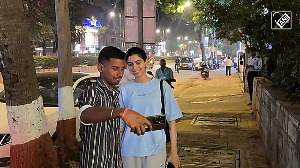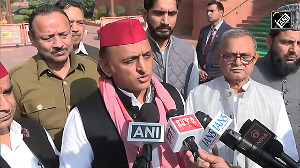PK Sethi, who died on January 6, has left behind a controversy over his invention of the Jaipur foot which refuses to die with him.
When Pramod Karan Sethi joined SMS Hospital in Jaipur in the 1950s and set up Rajasthan's first orthopaedic department and then its rehabilitation centre, it was the beginning of his journey to making the artificial foot now famous as the Jaipur foot.
Days after he died on January 6, Sethi's legacy is being questioned by the very NGO which is today known for taking the Jaipur foot to the masses. The invention won the doctor a Magsaysay award, which in turn has given him enemies.
The founder and chief patron of the Mahavir Viklang Sewa Samiti DR Mehta says that the doctor's contribution was limited to providing the medical technology for it. The sculptor who gave the aesthetic appearance to the foot and the NGO which propagated it deserve equal credit, he says.
He goes on to say that Sethi fixed just 40 limbs while the Samiti itself has fixed three lakh limbs till now. And that the Magsaysay for the doctor was not fully deserved.
A popular version of the invention of the foot is that a sculptor came to the surgeon with the idea of a prosthetic foot after he saw a man repair a cycle with a flat tyre
However, people close to the doctor say that the NGO fell out with the doctor as the latter turned down the former's request to patent the technology giving Mehta monopoly over it. It also got upset after the Magsaysay award was announced for Sethi.
Sethi never wanted to take individual credit for the Jaipur foot and he also refused to patent the technology he developed with scientific inputs from several others in IIT Bombay and Department of Science and Technology, saying that it should remain available for anyone to use, to modify and to improve upon. This was something which the NGO never accepted, says Sethi's daughter-in-law Vimala Ramachandran.
The NGO was cut-up with the fact that the Magsaysay went to the doctor rather than to Mehta who had quit IAS to set up the NGO to propagate the Jaipur foot, she says.
Today, the Jaipur foot is nobody's monopoly and if MVSS has fixed over three lakh limbs, then Gandhigram, an organisation in Mysore, has fixed as many, and so have several hospitals which have artificial limb centres not only in India but all over the world.
Sethi was against taking credit for the achievement and so, when an artificial limb centre funded by the American War Veterans in Pnom Penh was named Sethi Limb Centre, he got it changed, says Ramachandran. She also blasts the NGO's theory of the sculptor's role in the invention.
"How can a sculptor design a foot? He was hired by the doctor to teach sculpting to in-patients as part of a rehabilitation programme. How can a sculptor have a clue about technology?" she asks . The sculptor, Ramchandra Sharma, now in his 80s, has nothing to say on the controversy but just remembers the doctor as a family member.
However, Sethi's citation in the Magsaysay award mentions how the craftsman whom he called masterji worked closely with the doctor and how Sethi believed that doctors should set aside their ego and share their medical knowledge with the artisans and work for the service of society.
Mehta tries to tone down his rhetoric against Sethi to recall that the doctor was a great surgeon and had fixed his own limbs which were damaged in a car accident. All I have to say that his contribution was great as far as the technical side is concerned but zero on the social side.
"It is the society (MVSS) that has been propagating the limbs among the poor in the country and abroad. But the entire credit went to the doctor. He was even awarded for his so-called achievements for society even though he did not see a single patient in the last 25 years of his life," says Mehta.
But aside of the controversy, the focus on the Jaipur foot has also taken away emphasis on the other great legacy of Dr Sethi, the polyurethane callipers which he developed for polio afflicted children. It liberated millions of children from the metal strapped heavy callipers, says Ramachandran.






